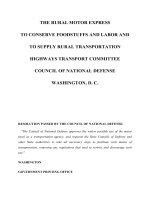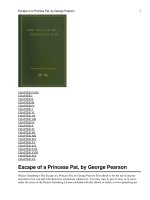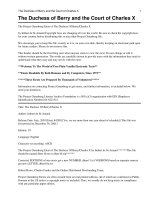Putting the TOC Thinking Processes to Use_1 potx
Bạn đang xem bản rút gọn của tài liệu. Xem và tải ngay bản đầy đủ của tài liệu tại đây (744.75 KB, 25 trang )
The Categories of Legitimate Reservation
49
entered the room. No lights came on. I went farther into the room, and
turned on the lights over the dresser and by the bed. No problem. I then
tried to turn on the lamp next to the table. No light. I looked at the bulb.
It had that dark, used-up look to it. I then made sure it was turned tightly
in its socket. Although the bulb was tight in the socket, the socket itself
was loose and was turned on its side.
Aha!
I thought. Must be a short,
or the bulb itself is out. I needed that lamp, because I had work to do
that evening. I called the front desk, and they sent
a gentleman from maintenance to fix the problem.
When he got to my room, I told him, “The lamp
doesn’t work.” Before he attempted to fix it, he did
something very important.
He had an entity exist-
ence reservation
and checked to make sure that the
lamp, in fact, wasn’t working. He went over to the
wall, found the unplugged cord, plugged it in, and
turned on the lamp. Guess what? The lamp worked. (Talk about an
embarrassing moment! Is it OK with you if we chalk it up to being tired?)
The entity existence reservation reminds us that we should check to
make sure (verify) a problem exists before we spend time figuring out
what’s causing it or how to solve it. As illustrated in the car battery
example of the previous chapter, it also reminds us that when we have
speculated a cause for something, we should make sure (verify) that those
(cause) entities also exist as entities in the reality we’re trying to under-
stand. (
Sure, a dead battery can be a cause for a car failing to start, but
is it so in
this
case? Use the entity existence reservation, and check first to
see if the battery is dead!
)
Warning: Don’t make this more difficult than it is. The entity existence
reservation is used merely to remind you to ask yourself a simple question:
Does this really exist? If the answer is yes, fine. If the answer is no,
excellent! You’ve saved yourself some work in the long run, because you
won’t be solving nonexistent problems. If the answer is “I don’t know,”
move on to the predicted effect reservation later in this chapter. Its purpose
is to help you systematically check those entities in particular.
Causality Existence
Do babies
really
come from storks?
Does smoking
really
cause cancer?
Will customers
really
buy our product if we lower our prices?
Figure 4.6
SL1019ch04frame Page 49 Friday, June 23, 2006 9:29 AM
Copyright © 1999 CRC Press, LLC.
50
Thinking for a Change
The
causality existence
reservation is used
when you are questioning the cause–effect rela-
tionship itself. In terms of the sufficient cause
diagram, the causality existence reservation
points directly to the assumptions that occupy
the space underneath the arrow, arrows, or and-
connector. It does not question the existence of
any of the entities, but rather the cause–effect
relationship
that is hypothesized to exist
between them. The causality existence reserva-
tion says,
OK, I believe the entities exist, but does
the
(
speculated
)
cause
r
eally
cause the effect?
Does the effect
really
exist simply because the
(
speculated
)
cause does?
Let’s say that someone showed you Figure 4.8.
What is your initial reaction? At first glance, you
might say, “Yes, I agree, thunder does follow
lightning.” Take another look and evoke the
causality existence reservation. Assume that both
of the entities exist, exactly as they are stated:
I hear thunder. I see lightning. Does the fact that
one sees lightning really cause that person to
hear thunder? Is hearing thunder an
inevitable
result
of seeing lightning? One might argue that
just because thunder tends to be audible after
lightning occurs, doesn’t mean that I will hear
thunder
because
I see lightning. Or does it?
Figure 4.9/11 illustrates a few ways in which this
diagram might be changed,
depending on the
realities of the situation
, as a result of applying the causality reservation.
This simple example helps us uncover two common behaviors that often
hinder our practices of thinking and communicating.
1. We have a tendency to confuse the sequential occurrence of events
over time with cause and effect. In a sufficient cause diagram, every
arrow denotes cause–effect. This is a significant departure from a
process flow diagram, in which the arrows typically signify sequence.
2. We always perceive things first from the perspective of our own
assumptions. It is the meaning that we attach to what we hear,
see, or read, that gives rise to agreement or disagreement. Whatever
your first response to the thunder and lightning example happened
to be, that response came from the assumptions that you made
about the diagram that you read.
Figure 4.7
Figure 4.8
SL1019ch04frame Page 50 Friday, June 23, 2006 9:29 AM
Copyright © 1999 CRC Press, LLC.
The Categories of Legitimate Reservation
51
Figure 4.9/11
SL1019ch04frame Page 51 Friday, June 23, 2006 9:29 AM
Copyright © 1999 CRC Press, LLC.
52
Thinking for a Change
The causality reservation gives us an opportunity to test our assumptions
against the reality of the validity of a cause–effect relationship — a relation-
ship that we are claiming, as well as one that we are reading or hearing.
War ning:
Don’t make this more difficult than it is. The causality
existence reservation is used to remind you to ask yourself a simple
question:
Does this cause–effect relationship really exist?
If the answer is
yes, fine. If the answer is no, excellent! You’ve saved yourself some work
in the long run, because you won’t be solving the wrong problem. If the
answer is “I don’t know,” move on to the Additional Cause and/or Cause
Insufficiency reservations later in this chapter.
Clarity
I continue to be impressed at how often things go wrong simply because
of a lack of clarity. For instance, have you ever found yourself in “violent
agreement” with a colleague? There are three scenarios in which the clarity
reservation is appropriate, and all three of these scenarios occur more
often than you think:
1. You are not understood by someone you are trying to communicate
with.
2. You do not understand what someone else is trying to communicate
to you.
3. You have not articulated your own thinking clearly enough to
yourself.
A matter that becomes clear ceases to concern us.
Nietzche, 1886
When an entity is not written as a complete statement, automatically
raise a clarity r eservation!
When you are writing the entity, be sure to
write it as a complete statement. It will be there as your own reminder
of what you mean. When you leave a diagram and come back to it some
time later, you will not have to second guess yourself as to what you meant.
If the entity is one that is being verbalized by someone else, know that
the only way you make sense of it is by completing a sentence in your
mind. For instance, let’s say you are having a conversation with the owner
of a small printing company. You can tell just by looking at his face that
SL1019ch04frame Page 52 Friday, June 23, 2006 9:29 AM
Copyright © 1999 CRC Press, LLC.
The Categories of Legitimate Reservation
53
he’s upset about something. You ask what’s troubling him. His response, as
he shakes his head, is, “Sales.” You might assume that his problem is that
his company’s sales are low or declining. What if I told you that the problem
is that his company’s sales are too high? You see, they executed a magnificent
marketing strategy, and now they are flooded with orders — orders that
they don’t have the capacity to produce. The executive is upset because he
fears that unless his company does something, many of the new customers
they attracted will leave because of poor service. The point here is that you
really had no idea what he meant by the word “sales” until you heard or
made up the remainder of a complete sentence — such as, “We don’t have
enough capacity to handle all of our new sales.”
To “dialogue” is to communicate in a way that expands the pool of
meaning or information, with a focus on creating and enhancing shared
purpose, mutual respect, and clarity of understanding. One of the princi-
ples of dialogue, as taught by The Praxis Group in Provo, Utah, is
Work
on me first, us second.
Like Steven Covey’s
Seek first to understand before
you seek to be understood
*
,
it reminds me that before I blame or complain
about anybody else, and before I assume that anybody else is wrong and
I’m right, I had better check inward first. I will admit, I do ignore the
principle from time to time, but when I do, I always end up regretting it.
When reading someone else’s diagram (or for that matter when listen-
ing to someone else speak or reading what they’ve written), if you are
inclined to disagree, assume first that you have a clarity reservation. This
means that you assume first that you are not fully understanding what
they are saying, before you assume that they’re wrong. You will find that
as you open yourself up to this practice, you will have fewer arguments
and better relations.
Level Two Reservations
The remaining three reservations are used when the questions posed with
the entity or causality existence reservations are unanswered. A reservation
is unanswered when there is still doubt among any of the parties involved.
4.
Additional cause
asks us to further examine causality existence by
looking for additional independent causes for the given effect.
5.
Cause insufficiency
also further examines causality existence by
looking for missing dependent elements of the cause.
6.
Predicted effect
is used to examine either causality or entity exist-
ence by utilizing the scientific method of effect–cause–effect.
* Covey, Stephen R.,
The 7 Habits of Highly Effective People
, Simon and Schuster, 1989.
SL1019ch04frame Page 53 Friday, June 23, 2006 9:29 AM
Copyright © 1999 CRC Press, LLC.
54
Thinking for a Change
Additional Cause
Is the new incentive system the
only
reason that morale has improved?
Was the price increase the
only
reason for the decrease in sales last
year?
Did Johnny fail his algebra class
only
because he was absent twenty
times in the semester?
The additional cause reservation
is used when you suspect that the
hypothesized cause is not the only
cause for the resulting effect. A good
test for additional cause is to ask, “If we removed the originally speculated
cause, would the effect still exist?” If the answer is yes, there is a good
chance that an additional cause exists. Let’s use Johnny’s case as an
example. Johnny failed his algebra course, and his
parents want to understand why. A conference
took place between Johnny, his teacher, and his
parents. When asked why Johnny failed, the
teacher told them that Johnny had been absent
20 times in the semester. That alone was sufficient
cause for failure, because only five absences were
allowed by the school. Together, they develop a
communication plan designed to ensure that
Johnny attends class. Johnny’s dad then asks the
teacher, “Let’s assume that our plan works, and
Johnny is in class every day next semester. Will he
pass, or is there anything else that we should be
awar e of?” Johnny’s dad expressed an additional
cause reservation. What else, in addition to the
poor attendance, caused Johnny to fail his algebra
class?
The teacher then tells Johnny’s parents that Johnny rarely turned in
his homework. This, too, was sufficient to earn Johnny his failing grade.
The group then expands the communication plan to include making sure
Johnny regularly turns in his homework. Anything else? Are his test scores
OK? When he’s in class, does he behave? Johnny’s mother raised the additional
cause reservation once more, just to be sure. No, said Johnny’s teacher. If
Johnny improves in these two areas, he should see a passing grade.
Figure 4.12
Figure 4.13
SL1019ch04frame Page 54 Friday, June 23, 2006 9:29 AM
Copyright © 1999 CRC Press, LLC.
The Categories of Legitimate Reservation 55
When utilizing the addi-
tional cause reservation, we
are using our intuition and our
experience as we think of
other potential causes for the
given effect. In her question-
ing process, Johnny’s mother
gave examples of other poten-
tial causes that she was aware
of for failing a course. The
only entities that remain on
the diagram are the entities
that do, in fact, cause the
effect in the system or situa-
tion that is under examination.
The question that you are attempting to answer with the additional
cause reservation is, Is there something else, independent of the cause(s)
alr eady speculated or validated, that is causing the effect? One way to get
there, as Johnny’s mother did, is to ask two questions:
1. Is there something else that might cause the effect?
2. Does that something else exist in the reality of the situation or system
that I’m examining?
It’s easy to overdo this res-
ervation, by adding so many
minor causes that the diagram
becomes meaningless. For
each cause, ask If we elimi-
nated this entity from exist-
ence, to what degree would its
effect still exist? Take a look at
Figure 4.15, which is what I
refer to as a pincushion. Let’s
say entity C provides for 50% of Z’s existence, entities D and A each
provide for 20%, and entities B and E each provide for 5%. If entity Z
were something that you wanted to change or improve, working to
eliminate B and E will not have much of an impact. In a case such as
this, my suggestion is to remove entities B and E from the diagram.
Figure 4.14
Figure 4.15
SL1019ch04frame Page 55 Friday, June 23, 2006 9:29 AM
Copyright © 1999 CRC Press, LLC.
56 Thinking for a Change
Insufficient Cause
The insufficient cause reservation
questions causality by identifying
one or more entities that must
exist along with the speculated
cause entity or entities in order for
the cause to be valid. The ques-
tions that we’re asking with this
reservation are:
1. Is there something else that
must exist in conjunction
with the speculated cause,
in order for the effect to
exist as a result?
2. Does that something exist in the reality of the system or situation
that I’m examining?
A manufacturer of temperature control devices
for the injection molding industry was experiencing
material shortages in manufacturing. In the process
of analyzing the problem, the purchasing manager said
that a cause for the material shortages was late deliv-
eries of purchased components by their vendors.
We encouraged the purchasing manager to exam-
ine her claim a bit further. It seemed that this situa-
tion, in and of itself, could not cause material
shortages to exist in manufacturing, because we
knew of many manufacturing companies that did
experience fluctuations in vendor performance yet
did not suffer from manufacturing shortages. We
posed a question:
• Did the company experience material shortages in manufacturing
every single time a vendor was late on delivery?
The answer to this question was no. The next thing we asked was,
What’s the difference between the two situations? Under what circum-
stances does manufacturing experience shortages as a result of late vendor
delivery, and under what circumstances does manufacturing not experi-
ence such shortages?
Figure 4.16
Figure 4.17
SL1019ch04frame Page 56 Friday, June 23, 2006 9:29 AM
Copyright © 1999 CRC Press, LLC.
The Categories of Legitimate Reservation 57
In most cases, purchasing requested
delivery dates from the company’s
vendors to coincide with manufactur-
ing’s production schedule. On some
parts, the company carried an inven-
tory in the stockroom. Manufacturing
shortages on those parts were typi-
cally not due to vendor performance,
but to other things (additional causes).
This analysis resulted in the manu-
facturer realizing that even though they
did experience some late deliveries
from their vendors, the effect — short-
ages in manufacturing — was a result of this combined with their own
policy to order materials just in time. They could choose to work on their
vendors, or they could choose to change their policy. Or some combination
of the two. The problem wasn’t just “out there in vendor land,” and that
was both humbling and empowering.
Like a chemical reaction, in reality it takes a combination of conditions
to cause another condition to exist. Understanding the elements of those
combinations can be quite important as we endeavor to make improve-
ments in our organizations and our lives.
•We gain an understanding of the circumstances in which the cause
is or is not a cause, and thus a better understanding of the
circumstances in which a given solution will or will not lead to
the desired outcome.
•We uncover more avenues and choices for solutions. Quite often,
the newly discovered avenues are much more within our own
realm of control or influence than previously believed.
After several rounds of clarity, additional cause, and insufficient cause
reservations, our manufacturer’s analysis of material shortages looked like
Figure 4.19. Please note that Figure 4.19 is not a “pincushion.” It contains
three distinct and major causes for the effect.
Be careful to keep the sufficient cause diagram practical. If you find,
for instance, that as a result of using the insufficient cause reservation
you have more than four entities bound by an and-connector, one of two
conditions exists:
•You have several layers of causality embedded in the diagram, in
which case you should apply the causality reservation to clarify
the cause–effect relationships.
Figure 4.18
SL1019ch04frame Page 57 Friday, June 23, 2006 9:29 AM
Copyright © 1999 CRC Press, LLC.
58 Thinking for a Change
•Your diagram is overloaded with entities that are trivial — so
obvious that their only purpose seems to be to clutter up the tree.
Take a look at this example, which was first presented to me by Dale
Houle, Managing Partner of the Avraham Y. Goldratt Institute:
You observe a torch burning in the stadium. Why
is there a torch burning in the stadium? Well, because
it’s the opening day of the Olympics! You are prac-
ticing your sufficient cause diagrams and draw it as
Figure 4.20.
Well, my friend tells me that my diagram is
incomplete. She claims that in order for my claim
to be valid, there must also be oxygen present in
the stadium. She claims that my diagram should look
like Figure 4.21.
To most of us, the addition of the “oxygen” entity,
although correct in reality, really adds nothing but
clutter to the diagram. Now, I suppose when we
ultimately discover life on other planets, and the
Olympics becomes an intergalactic event, the “oxy-
gen” entity will be more relevant.
Figure 4.19
Figure 4.20
SL1019ch04frame Page 58 Friday, June 23, 2006 9:29 AM
Copyright © 1999 CRC Press, LLC.
The Categories of Legitimate Reservation 59
When I say keep it practical, I
mean keep it meaningful for the
people who need to be involved
in using (creating, reading, com-
municating) the diagram. If you are
trying to obtain clarity of under-
standing, contributions to an anal-
ysis or solution, or consensus on
a given subject, don’t remove an
entity just because it’s “oxygen” to
you. Doing so will send the mes-
sage to your colleagues that their
understanding is inferior to yours.
This is not the message you want
to send if you’re looking for col-
laboration. Only remove an entity if all concerned agree that it’s “oxygen.”
Predicted Effect
The thinking processes were
founded on the predicted effect
reservation. The rest of the reser-
vations were discovered later, as
we gained better understanding of
what the predicted effect reserva-
tion was actually accomplishing.
Predicted effect is nothing more
than the scientific method. For a
given effect, speculate its cause.
Try to invalidate your hypothesis
by predicting another effect that
must result from the cause, and
check for the existence of that
effect. If the predicted effect does exist in the reality of the system or
situation you are examining, then your hypothesis has passed a test of
validity. If the predicted effect doesn’t exist in that system or situation,
then you have in some way invalidated your original hypothesis. This is
why the thinking processes are often called “effect–cause–effect” thinking.
The predicted effect reservation is used to check for entity existence,
especially when the entity is something intangible and difficult to verify
physically. It is also used to validate cause–effect relationships.
Figure 4.22
Figure 4.21
SL1019ch04frame Page 59 Friday, June 23, 2006 9:29 AM
Copyright © 1999 CRC Press, LLC.
60 Thinking for a Change
Let’s visit a nationwide distributor of electronic
components who is trying to understand a substantial
decrease in sales volume in spite of an increasing
market for the types of products it sells. Many of the
salespeople are complaining that an across-the-board
price increase is the major reason for the drop in
volume.
Let’s say that the group generally agrees with this
hypothesis. It is certainly an easy conclusion to reach,
as most of the salesforce complained bitterly at the
time the price increase was introduced. What would
their next action likely have been? Of course, they
would introduce a price cut. They would probably
do it with pizzazz, announcing that they would meet
or even beat their competition’s prices. That might be all right, but what
if the price increase wasn’t the major reason for the decrease in sales?
How can we check? Here’s where the predicted effect reservation comes
in handy.
The great tragedy of Science — the slaying of a beautiful
hypothesis by an ugly fact.
Thomas Henry Huxley, 1870
The common practice would have us go about looking for all the evidence
we can find to substantiate the claim that the price increase is the culprit.
The predicted effect reservation takes a different approach. It asks:
• What entity, if we found it in reality, would prove our hypothesis
wr ong ?
In this case, we might suggest that the company look for any of the
following:
• Sales that were lost to higher priced competitors. If customers are
migrating from the distributor to a higher priced source, then
declining sales must be due to a reason other than price.
• Customers who are still buying products from this distributor that
they can find cheaper elsewhere.
Figure 4.23
SL1019ch04frame Page 60 Friday, June 23, 2006 9:29 AM
Copyright © 1999 CRC Press, LLC.
The Categories of Legitimate Reservation 61
If they found either of these to exist, then their initial hypothesis would
be proven incorrect. They would not be able to claim that the price
increase, in and of itself, was responsible for the downturn in sales. Here’s
what the ensuing discussion uncovered:
In one area of the country, they were losing sales to higher priced
competition. The competition was a smaller distributor who had recently
hired away this distributor’s best salesperson. With the salesperson went
the years of relationships he had developed. His customers eagerly fol-
lowed him to the other company. This accounted for 60% of the drop in
sales in that area, and 15% of the drop in the company’s sales.
In another area of the country, they were also losing sales to higher
priced competition. It seemed that a new distributor opened up last year.
At the time, they were “written off” as “nothing to worry about.” A new
upstart with crazy ideas. They offered customized services, such as daily
replenishment, no minimum order, dedicated customer service people,
and 24-hour access. This type of service was almost unheard of in this
area, and most distributorships didn’t believe customers would pay for it,
nor did they believe that doing business in this way could be profitable.
This situation accounted for about 50% of the drop in sales in that area,
and 30% of the drop in the company’s sales.
Both of the above scenarios pointed to the relationships the company
maintained with its customers rather than its pricing strategy.
Finally, the company examined some of its customers who, in spite
of the fact that they could buy products cheaper from other sources, chose
to stay with the company. Generally, these customers chose to stay because
of the rapport they had established with the distributor over the years.
They felt that they could count on good service, they believed that the
salesperson they worked with had their best interests at heart, and they
knew they could count on their salesperson to come through for them
when needed.
So it seemed that in many of the cases, customers left or stayed not
because of price, but because of relationship. After all of that, the diagram
now looked like Figure 4.24.
Using the predicted effect relationship helped to uncover additional,
important aspects of the cause–effect relationship that were not evident
before. The company now has the opportunity to work at market seg-
mentation in a way that preserves and enhances their customers’ percep-
tion of value, and subsequently the prices they pay. They have an
opportunity to work on developing strong relationships and new services
that will foster that increased perception of value. If they choose, they
can carefully select products and/or markets in which to play the price
game.
SL1019ch04frame Page 61 Friday, June 23, 2006 9:29 AM
Copyright © 1999 CRC Press, LLC.
62 Thinking for a Change
Reservations Disguised as Common Expressions
We use these reservations every day, but often don’t realize it. Do you
remember the car battery example? As soon as we started to check the
lights and the radio, we were using predicted effect.
Here are ways in which reservations are expressed in our day-to-day
conversation:
Oh, really?!
No way!
Yeah, but…
Bull- !
I don’t think so…
No, I think it’s [fill in the blank].
Some Guidelines
When you are on the receiving end of communication, use the clarity
reservation first. It shows that before you assume the other person is
incorrect, you first assume that you might not fully understand what he
or she is trying to communicate.
Figure 4.24
SL1019ch04frame Page 62 Friday, June 23, 2006 9:29 AM
Copyright © 1999 CRC Press, LLC.
The Categories of Legitimate Reservation 63
When you are creating sufficient cause diagrams, don’t worry about
using the clarity reservation first, but remember that you are not ready to
show your diagram to anybody else until you have applied the clarity
reservation to it.
When you are ready to share a diagram with others, add whatever is
necessary to make it clear. Don’t leave entities off because you consider
them to be “oxygen” if someone involved in the diagram believes the
entity to be more relevant than that.
Don’t forget to put on your learning hat, and remember that you are
trying to prove yourself wrong every step of the way. This is an about-
face from our common practice of “being right” and trying to substantiate
our claims every step of the way. I hope that you have seen a glimpse
of the benefits of this type of outlook — you empower yourself to learn
and to recognize opportunities that you were previously blind to.
Skill Builder: Using the Categories
of Legitimate Reservation
The more often you do the following exercise, the more proficient you
will become in the use of the categories of legitimate reservation, sufficient
cause thinking, and communicating.
1. Think of a sufficient cause relationship and write it down.
2. Give a copy of this to a friend or colleague and ask them to write
down any questions or disagreements they may have with the
statement.
3. Create a sufficient cause diagram of the relationship you wrote
down in step one.
4. For each question or disagreement that your friend wrote, identify
the reservation category that he or she is expressing.
5. Make any modifications to the drawing necessary to resolve each
reservation (by adding and/or subtracting entities and arrows) (see
Figures 4.25 and 4.26).
6. Continue this process until your friend says something like, “I have
no more questions — this is crystal clear, makes sense, and I
believe it!”
SL1019ch04frame Page 63 Friday, June 23, 2006 9:29 AM
Copyright © 1999 CRC Press, LLC.
64 Thinking for a Change
Figure 4.25
SL1019ch04frame Page 64 Friday, June 23, 2006 9:29 AM
Copyright © 1999 CRC Press, LLC.
The Categories of Legitimate Reservation 65
Figure 4.25 (continued)
SL1019ch04frame Page 65 Friday, June 23, 2006 9:29 AM
Copyright © 1999 CRC Press, LLC.
66 Thinking for a Change
Figure 4.26
SL1019ch04frame Page 66 Friday, June 23, 2006 9:29 AM
Copyright © 1999 CRC Press, LLC.
The Categories of Legitimate Reservation 67
Figure 4.26 (continued)
SL1019ch04frame Page 67 Friday, June 23, 2006 9:29 AM
Copyright © 1999 CRC Press, LLC.
69
Chapter 5
Necessary Condition
Thinking
Necessity is an evil; but there is no necessity for continuing
to live subject to necessity.
Epicurus, 3rd Century B.C.
Necessary Condition
is the thought pattern we use when we are thinking
in terms of
requirements
. When we think that something
must
exist before
we are able to achieve something else, we are using necessary condition
thinking. Terms such as
must, must not, cannot, need,
and
have
are
indicators of necessary condition thinking.
Necessary conditions are rules, policies, or laws, that provide the
limitations, or boundaries within which we believe we are allowed to
pursue goals and objectives. Conformance with a necessary condition
does not guarantee that a goal will be achieved, but we usually believe
that if we don’t have the perceived necessary condition in place, we will
certainly be unable to attain that goal.
Here are some examples of necessary condition thinking:
•
A person must be at least 35 years of age to be the President of the
United States.
•
I can’t be physically fit unless I exercise.
•
We must reduce our costs in order to get higher profits.
SL1019ch05frame Page 69 Friday, June 23, 2006 9:31 AM
Copyright © 1999 CRC Press, LLC.
70
Thinking for a Change
Our interpretations of necessary condition relationships shape our
perceptions of what we are and are not able to do. Often, we limit our
opportunities by believing strongly in necessary conditions that aren’t, or
don’t need to be. As a result, we block ourselves from seeing and acting
upon many simple, practical, creative, and speedy ways to achieve our
objectives.
A Simple Example
The following example (Figure 5.1) can be found in many texts and
workshops on creative thinking, and you may have experienced it before.
Without lifting your writing instrument, and without retracing any lines,
connect all nine dots by drawing four straight lines. If you have difficulty
accomplishing this task, you are assuming a necessary condition that
doesn’t exist. If you are familiar with this puzzle, try it with three lines,
two lines, or just one line. Hints and answers are provided in the Appendix.
Please, try the exercise before you look! A hint: What are you assuming
about the instructions that is not explicitly stated in the instructions? Yes,
it is possible!
Figure 5.1
SL1019ch05frame Page 70 Friday, June 23, 2006 9:31 AM
Copyright © 1999 CRC Press, LLC.
Necessary Condition Thinking
71
Defining, Understanding, and Changing Necessary
Condition Relationships
The Thinking Processes provide systematic, three-step processes to chal-
lenge perceived necessary conditions through uncovering and challenging
the assumptions that formulate the necessary condition relationship.
1. Diagram the necessary condition relationship.
2. Surface the underlying assumptions.
3. Brainstorm alternatives.
Diagram the Necessary Condition Relationship
Every necessary condition diagram is comprised of the following elements:
1. Entity (Figure 5.2)
2. Arrow (Figure 5.3)
3. Necessary condition
(Figure 5.4)
4. Objective (Figure 5.5)
5. Assumption (Figure 5.6)
Entity
An entity is a single element of
the system. Although the suffi-
cient cause processes require
that entities be written as com-
plete sentences, it is not a
requirement in necessary con-
dition diagrams.
Arrow
An arrow indicates a relationship between two entities. The entity at the
base of the arrow is the
necessary condition
(see Figure 5.4). The entity
at the point of the arrow is the
objective
(see Figure 5.3).
Figure 5.2
SL1019ch05frame Page 71 Friday, June 23, 2006 9:31 AM
Copyright © 1999 CRC Press, LLC.
72
Thinking for a Change
Necessary Condition
An entity is a
necessary condition
when it is considered to be required
in order for another entity (the objective) to exist or to be allowed to
exist. The necessary condition is located at the base of an arrow (see
Figure 5.4).
Objective
An entity is an
objective
when it is thought that the entity cannot exist
unless another entity, the necessary condition, exists as well. The objective
is located at the point of an arrow (see Figure 5.5).
Figure 5.3
Figure 5.4
SL1019ch05frame Page 72 Friday, June 23, 2006 9:31 AM
Copyright © 1999 CRC Press, LLC.
Necessary Condition Thinking
73
Assumption
An assumption is a reason for the existence of the necessary condition
relationship — a reason that one entity is required in order for another
to exist. You might say that the arrow represents the “space” where the
assumptions hide. When somebody says, “what’s underneath the arrow,”
they are really asking you to explain the assumption that connects the
necessary condition to the objective. Assumptions are valid or invalid (see
Figure 5.6).
Figure 5.5
Figure 5.6
SL1019ch05frame Page 73 Friday, June 23, 2006 9:31 AM
Copyright © 1999 CRC Press, LLC.
74
Thinking for a Change
Reading the Necessary Condition Diagram
(Before Assumptions)
You can check a necessary condition diagram by reading it back to
yourself. Any of the following statements should flow smoothly when you
have filled in the blanks with the relevant entity:
• In order to achieve [objective], I must [necessary condition].
• Before we can accomplish [objective], we must [necessary condition].
•We can’t get [objective] without [necessary condition].
•You have to [necessary condition] before you’ll be able to [objective].
• Unless we have [necessary condition], it will be impossible to
achieve [objective].
Reading the Necessary Condition Diagram
(Including Assumptions)
Any of the following statements should flow smoothly when you have
filled in the blanks with the relevant entity:
• In order to achieve [objective], I must [necessary condition] because
[assumption].
• Before we can accomplish [objective], we must [necessary condi-
tion], because [assumption].
• Because of [assumption], we can’t get [objective] without [necessary
condition].
• Due to [assumption], you have to [necessary condition] before you’ll
be able to [objective].
• Unless we have [necessary condition], it will be impossible to
achieve [objective], because [assumption].
Examples
Using the nomenclature described above, the examples of necessary
condition thinking described at the beginning of this chapter can be
diagrammed as in Figure 5.7.
SL1019ch05frame Page 74 Friday, June 23, 2006 9:31 AM
Copyright © 1999 CRC Press, LLC.









